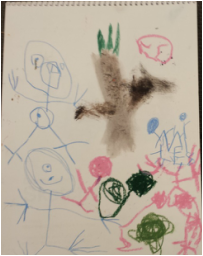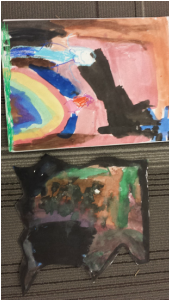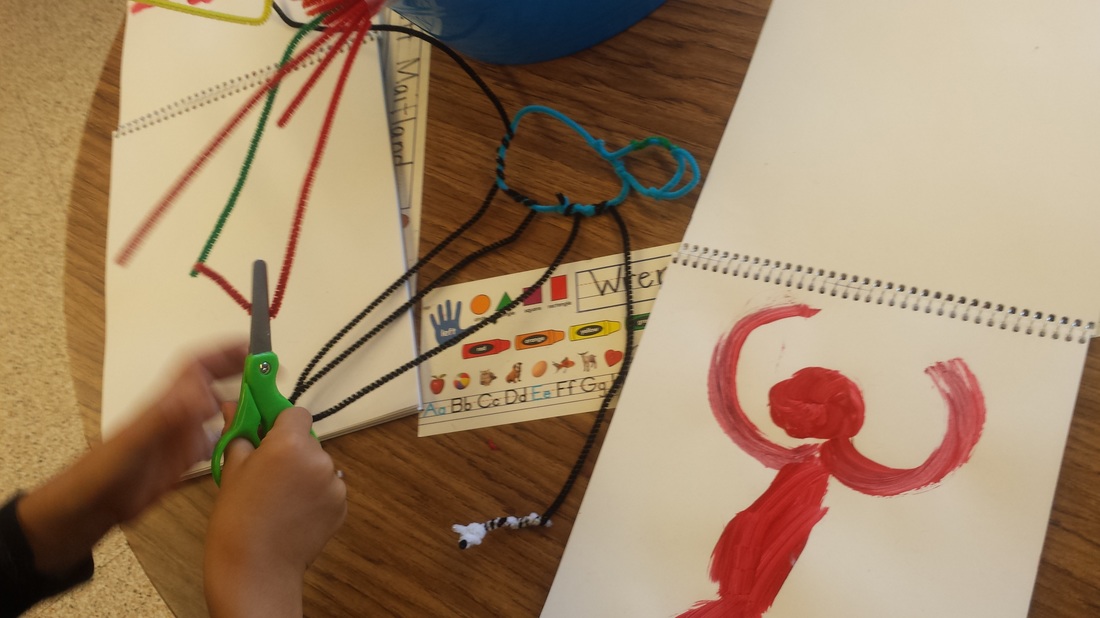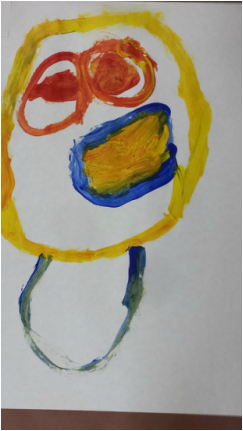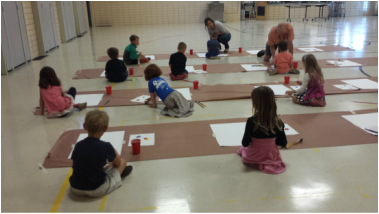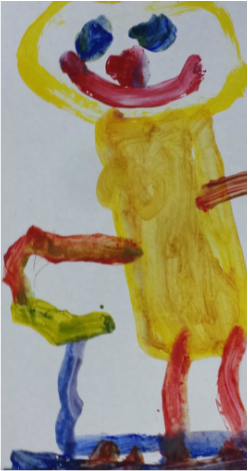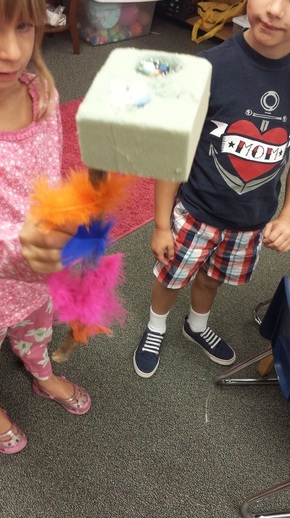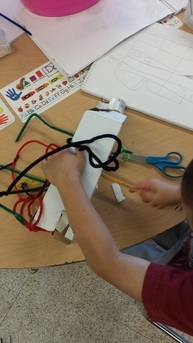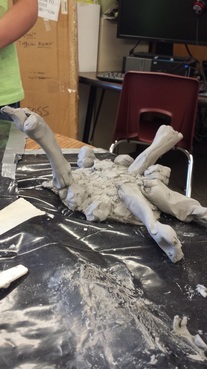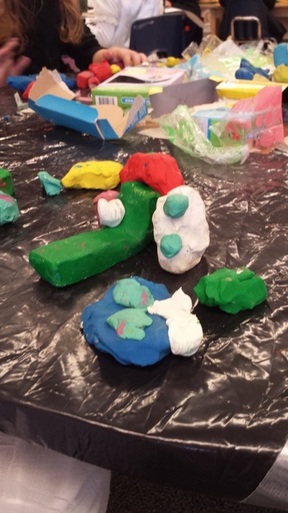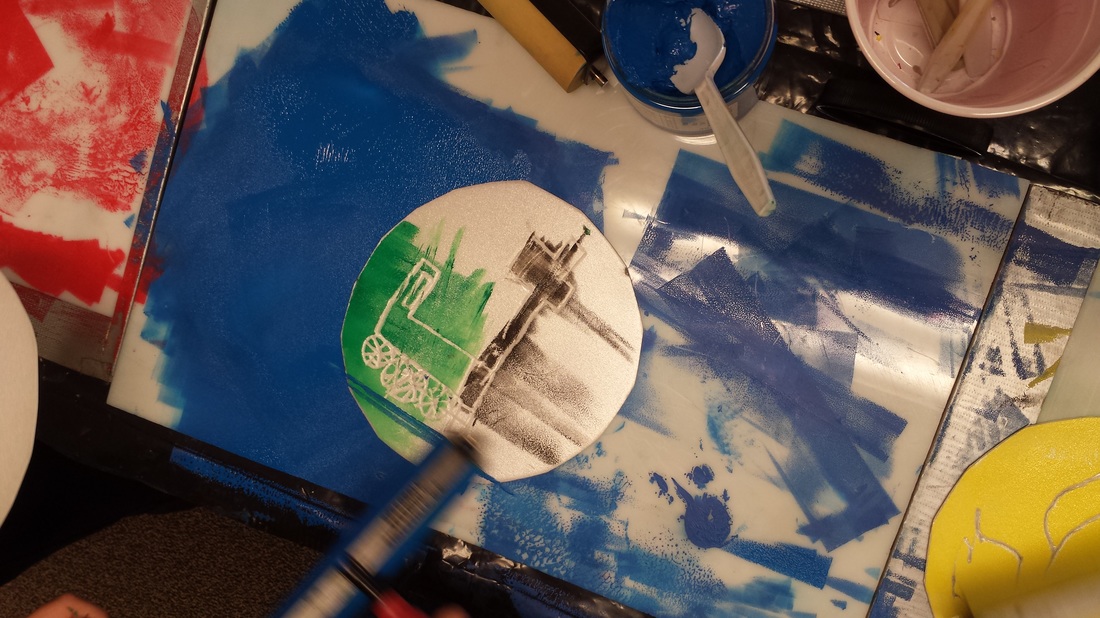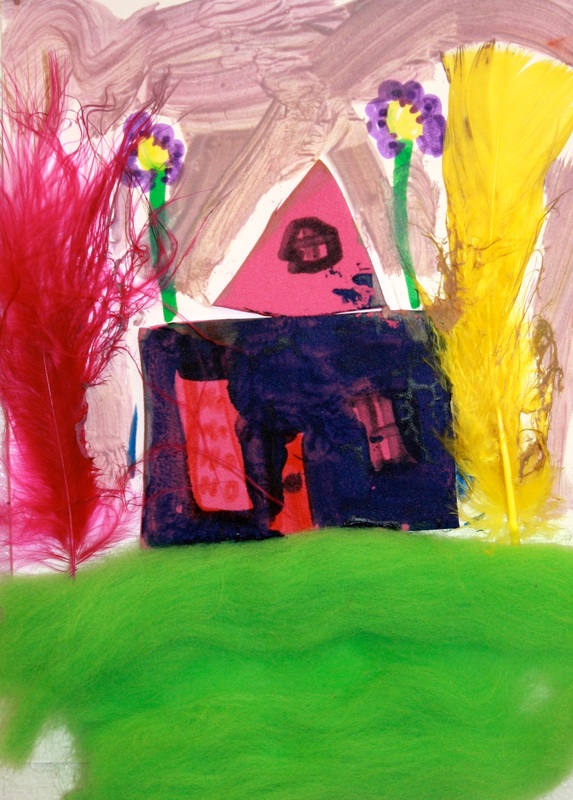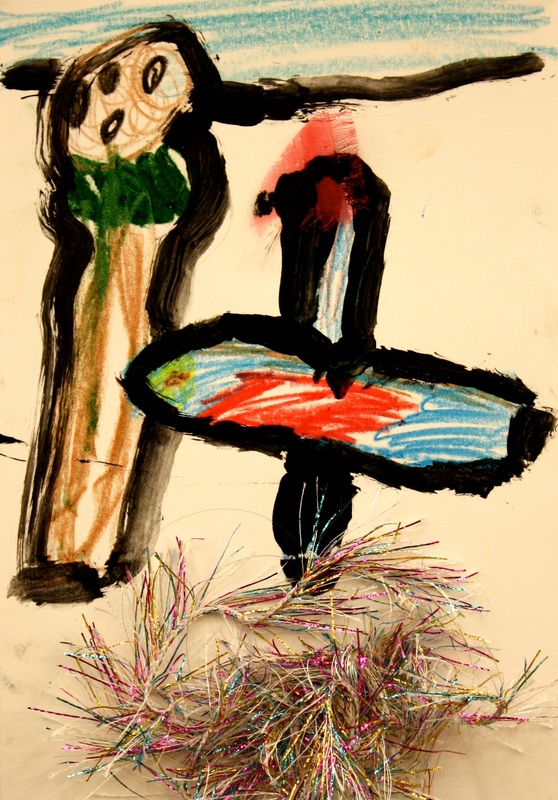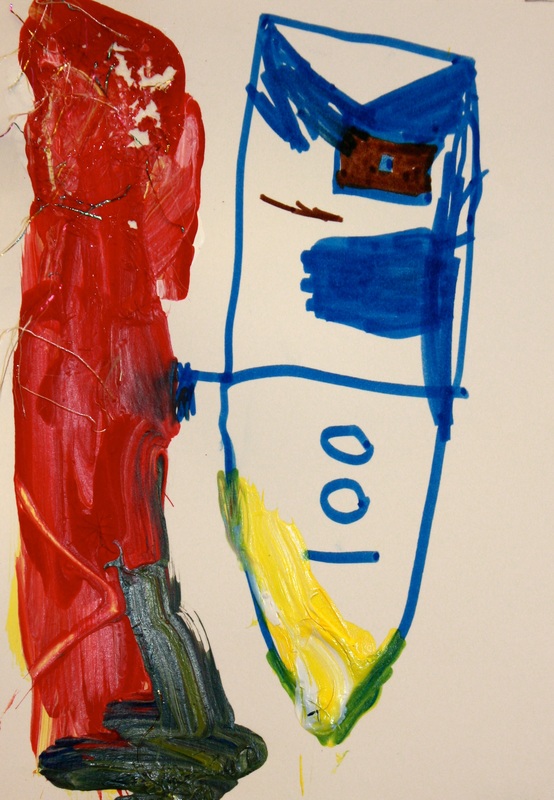Jenna Lewis
Sequence and Organization of the Unit
The unit for this semester had two focusing lenses, Motion and Story telling, Story telling was used throughout the entire unit while motion was only a large focus for three lessons. Motion was integrated into the unit to help continue learning that students would already be doing in their core subjects. Polaris has themes or units that the entire school focuses on each semester and this semester was motion so that is why motion was integrated into some of the lesson this semester. Story telling was a large part of the unit because it was important for students to understand that art can be used to tell stories about personal experiences or ideas.
Methods for Integrating Literacy, Numeracy, and Technology
Literacy: Literacy was a very big part of our unit because of the focus on storytelling. In each lesson, the students worked on their oral storytelling skills which was documented by the teachers. Towards the end of the unit, students began writing stories to go along with their illustrations. Also towards the end, students began explaining their artworks to the class by discussing artistic decisions and artistic intent.
Numeracy: Instruction for most lessons were sequential order. Whether students were working on one medium as a class or creating in centers, they followed steps to create their projects. Most classes began by students planning in their sketchbooks, at times in a grid format. Then, we would have demonstrations where there were a number of steps to follow. For example, relief printing was explained in a sequential order: first draw on the styrofoam plate, second roll ink onto breyer, third press the plate onto a sheet of paper, fourth pull plate off of paper. Students were expected to follow the correct steps while using materials like this.
Technology: Because students were so young, we did not spend much time using technology. We would begin each class with a presentation on the SmartBoard, but other than that did not really use other forms of technology. There were a variety of art tools the students learned to use throughout the course of the semester. For example, students learned how to safely use hot glue guns, tools for clay (like forks), and brayers to roll on ink for printmaking.
Strategies for Classroom Management
Describe management strategies employed during your lessons to ensure student success. Discuss any specific plans needed for lessons because of materials used, cooperative learning, etc. Discuss set-up, organization and clean-up for your lessons in this section.
When it comes to managing student behavior, there were some very difficult times but we both greatly improved. During the instructional parts of lessons, there were times when students were very excited or were distracting each other. If it was one or two students, we would simply ask them to be polite while others were talking. If many of the students needed to redirect, we would ask them to “catch a bubble.” We would have to remind them to pop their bubbles quietly or else they would get silly and make noises. Sometimes, I would dismiss students whose eyes were on me and smiling as big as they could. This also got students to focus. We learned to dismiss students one at a time or by groups instead letting them all go when you say. It was mentioned by our classroom teacher that explaining to students they can do something when you say go makes them lose focus on the expectations because the anticipation is too exciting for them.
Our delivery of instruction got much better the more we tried. We quickly learned the type of language to use with this age group. Also, we learned not to assume what students know, because they are all coming into school with different backgrounds and experiences. We would ask students to explain concepts or techniques before delivering new information to see how in depth we needed to go. A tip we got that helped our instruction was to tell students what they are to do rather than ask if they can do something for you. This age group tested us a lot at first to see what they could get away with doing or not doing, but we got much better during the semester.
We never found a really good clean up strategy with this group. We struggled with materials like found objects and paints. The most effective way we found was to appoint a couple students to collect or organize materials like water cups or paint brushes while the rest of the class cleaned up things like markers or pastels. However, when the students went to recess, Nicole and I still had a lot to pick up. Clean up was something we definitely could have spent more time planning.
Lesson 1: We are all just puzzle pieces
The teachers want to get to know the students, so students will make a sketchbook cover and puzzle piece that express the students and their interests and personalities.
“You are a successful artist! A lot of the time, artists make art about things that they like and see in their world. Today, we are going to make art about who we are! What are things that you see every day? What are some of your favorite things? What do you do for fun? Who are your favorite people? We will sketch in our sketch books to plan out a cover, then we will decide what things we will put on our covers. Think about what you like and what will show who you are.
Now that we talked about and created art that shows who we are, we are going to do another project. We each have our own interests and favorite things, which is great! But we are also in kindergarten now and all in one class, a group. We can all be ourselves, but we can participate and enjoy others in our groups. In art class, we will have lots of our own ideas and discoveries, but we will also work together and help each other make great art.”
Lesson PGCs
Recognize, compare, and affirm that the making and study of art and design can be approached from a variety of viewpoints, intelligences, and perspectives
Identify, compare and justify that the visual arts are a way to acknowledge, exhibit and learn about the diversity of peoples, cultures and ideas
Lesson Enduring Understandings
Art and the creative process allows for students to express and communicate personal connections and interests.
Lesson Inquiry Questions
What is your art about? Why? What colors do you use for your art? Why? What kinds of materials do you use? Markers? Colored Pencils? Paint? Why? How do you choose?
Objectives
- Given sketchbooks and drawing materials, TSWBAT plan different ideas to personalize their sketchbook covers. (Bloom’s:Applying- Standard: # 1 - GLE: #1.1 -Art learning: Ideation - Numeracy, Literacy)
- Given individual shapes of a puzzle, TSWBAT recognize that smaller shapes put together makes bigger shapes. (Bloom’s:Analyzing - Standard:# 3 - GLE: # 3.1 -Art learning: Comprehend - Numeracy, Literacy)
- By providing choice with various drawing mediums, TSWBAT explore and compare different materials. (Bloom’s: Analyzing - Standard: # 4 - GLE: # 4.1 -Art learning: Exploration - Numeracy, Literacy)
- By discussing the art created by the visiting artists, TSWBAT observe contemporary art practices. (Bloom’s: Understanding - Standard: # 1 - GLE: # 1.1 -Art learning: Observation - Numeracy, Literacy)
- By discussing the personal relevance of contemporary artists and the teachers, TSWBAT make connections between their personal interests and their art practice. (Bloom’s: Understanding - Standard: # 2 - GLE: # 2.1 -Art learning: Connections -Numeracy, Literacy)
- Through group discussions at the end of the projects, TSWBAT communicate their process and personal relevance to their peers. (Bloom’s: Understanding - Standard: # 2 - GLE: # 2.1 -Art learning: Communicate -Numeracy, Literacy)
- Through connecting students work into one piece at the end of class (puzzle project), TSWBAT model collaboration in the creative art process. (Bloom’s: Creating - Standard: # 4 - GLE: # 4.1 -Art learning: Collaboration -Numeracy, Literacy)
Below is a link to the lesson plan, the plan includes student reflective activities as well as the assessment instrument used for this specific lesson.
Students created sketchbook covers and puzzle pieces that were unique to each individual. Students were able to explore the idea of art being a way to express personal interests and story telling.
Lesson 2: Movements
Students will paint and sculpt what it looks like for a figure to be in motion. Students will practice drawing each other in motion then build a figure with pipe cleaners.
“You are going to be sculptors today! And our creation is going to focus on movement! As a sculptor, we have the option to use many different materials. Today, we are going to use pipe cleaners to make a sculpture of a person or figure who is moving.”
Lesson PGCs
Recognize, articulate and debate that the visual arts are a means for expression
Analyze, interpret, and make meaning of art and design critically using oral and written discourse.
Lesson Enduring Understandings
Art work planned in a two-dimensional format can be transformed into a three-dimensional art work that captures movement.
By exploring our body movements and positions, students will assemble a three-dimensional art work that captures a figure or object in motion.
Lesson Inquiry Questions
If you were playing soccer what would it look when you kicked the ball? What does it look like to run? What does dancing look like? How do you know? What is their body doing as they move?
Objectives
Students will paint and sculpt what it looks like for a figure to be in motion. Students will practice drawing each other in motion then build a figure with pipe cleaners.
“You are going to be sculptors today! And our creation is going to focus on movement! As a sculptor, we have the option to use many different materials. Today, we are going to use pipe cleaners to make a sculpture of a person or figure who is moving.”
Lesson PGCs
Recognize, articulate and debate that the visual arts are a means for expression
Analyze, interpret, and make meaning of art and design critically using oral and written discourse.
Lesson Enduring Understandings
Art work planned in a two-dimensional format can be transformed into a three-dimensional art work that captures movement.
By exploring our body movements and positions, students will assemble a three-dimensional art work that captures a figure or object in motion.
Lesson Inquiry Questions
If you were playing soccer what would it look when you kicked the ball? What does it look like to run? What does dancing look like? How do you know? What is their body doing as they move?
Objectives
- Using gesture drawings, TSWBAT create a sculpture of a figure or an object in motion. (Bloom’s: Creating - Standard: # 3 - GLE: # 3.1 -Art learning: Create -Numeracy, Literacy)
- Given pipe cleaners, TSWBAT build a figurative sculpture in action. (Bloom’s: Creating - Standard: # 3 - GLE: # 3.1 -Art learning: Create -Numeracy, Literacy)
- Given examples of Mason and Giacometti, TSWBAT identify how movement was captured. (Bloom’s: Analyzing - Standard: # 2 - GLE: # 2.1 -Art learning: Identify -Numeracy, Literacy)
- By using the discovery board, TSWBAT communicate and express how they portrayed movement in their sculptures and drawings. (Bloom’s: Remembering - Standard: # 4 - GLE: # 4.1 -Art learning: Communicate -Numeracy, Literacy)
Lesson 3: Movement Paintings
Students will create scenes of them doing something they like that shows motion.
“You are a painter who focuses on trying to capture figures in motion. Sometimes you paint people swimming and other times you paint them playing tennis! You have decided that you want to focus on yourself and make a painting that shows what you love to do.”
Lesson PGCs
Recognize, articulate and debate that the visual arts are a means for expression
Use specific criteria to discuss and evaluate works of art.
Lesson Enduring Understandings
By exploring our body movements and positions, students will create two-dimensional art work that captures a figure or object in motion.
Lesson Inquiry Questions
If you were playing soccer what would it look when you kicked the ball? What does it look like to run? What does dancing look like? How do you know? What is their body doing as they move?
Objectives
Students will create scenes of them doing something they like that shows motion.
“You are a painter who focuses on trying to capture figures in motion. Sometimes you paint people swimming and other times you paint them playing tennis! You have decided that you want to focus on yourself and make a painting that shows what you love to do.”
Lesson PGCs
Recognize, articulate and debate that the visual arts are a means for expression
Use specific criteria to discuss and evaluate works of art.
Lesson Enduring Understandings
By exploring our body movements and positions, students will create two-dimensional art work that captures a figure or object in motion.
Lesson Inquiry Questions
If you were playing soccer what would it look when you kicked the ball? What does it look like to run? What does dancing look like? How do you know? What is their body doing as they move?
Objectives
- Using gesture drawings and ideas from last class, TSWBAT create a painting of a figure and objects in motion. (Bloom’s:Creating - Standard: # 3 - GLE: # 3.1 -Art learning: Create -Numeracy, Literacy, and Technology)
- Given acrylic paint, TSWBAT mix colors and apply those colors on their paper. (Bloom’s: Applying - Standard: # 3 - GLE: # 3.1-Art learning: Explore -Numeracy)
- Given examples of Roset and Meyerson, TSWBAT identify how movement was captured. (Bloom’s: Analyzing - Standard: # 2- GLE: # 2.1 - Art learning: Identify - Numeracy, Literacy, and Technology)
- By using the discovery board, TSWBAT communicate and express how they portrayed movement in their paintings. (Bloom’s: Remember - Standard: # 2 - GLE: # 2.1 -Art learning: Communicate - Numeracy, Literacy)
- Using their completed artworks, TSWBAT explain their decision making process and story behind their painting. (Bloom’s:Understanding - Standard: # 4 - GLE: # 4.1 -Art learning: Intent -Numeracy, Literacy)
Lesson 4: Found Object Transportation Sculptures
Students will create sculptures made of found objects that are modes of transportation.
“20 years into the future, you are one of the top builders in the world! You are asked to build a new form of transportation. You have to come up with a new idea, this means that you can combine features of transportation that are already invented or completely invent a new one! We will use found objects to show your new invention. The future of moving across the town depends on you!”
Lesson PGCs
Recognize, compare, and affirm that the making and study of art and design can be approached from a variety of viewpoints, intelligences, and perspectives.
Use specific criteria to discuss and evaluate works of art.
Understanding of motion and historical background will ignite creative thinking and storytelling.
Lesson Enduring Understandings
Materials and stylistic decisions display artist intention that portrays movement and creative modes for transportation.
Lesson Inquiry Questions
How do you get around? How has technology changed over time?
Objectives
Students will create sculptures made of found objects that are modes of transportation.
“20 years into the future, you are one of the top builders in the world! You are asked to build a new form of transportation. You have to come up with a new idea, this means that you can combine features of transportation that are already invented or completely invent a new one! We will use found objects to show your new invention. The future of moving across the town depends on you!”
Lesson PGCs
Recognize, compare, and affirm that the making and study of art and design can be approached from a variety of viewpoints, intelligences, and perspectives.
Use specific criteria to discuss and evaluate works of art.
Understanding of motion and historical background will ignite creative thinking and storytelling.
Lesson Enduring Understandings
Materials and stylistic decisions display artist intention that portrays movement and creative modes for transportation.
Lesson Inquiry Questions
How do you get around? How has technology changed over time?
Objectives
- Using sketches, TSWBAT devise characteristics they will incorporate into their three-dimensional structure. (Bloom’s:Creating - Standard: # 3 - GLE: # 3.1 - Art learning: Ideation - Numeracy, Literacy, and Technology)
- Provided a slide show on transportation, TSWBAT to identify how technology has influenced the ways humans travel around the world. (Bloom’s: Analyzing - Standard: # 2 - GLE: # 2.1 - Art learning: Identify - Numeracy, Literacy, and Technology)
- Given pipe cleaners, TSWBAT create a transportation object that incorporates realistic characteristics or fictional creations using additive techniques. (Bloom’s: Creating - Standard: # 3 - GLE: # 3.1 - Art learning: Create - Numeracy, Literacy, and Technology)
- Using completed art work, TSWBAT summarize a story of how their invention will work. (Bloom’s: Understanding - Standard:# 2 - GLE: # 2.1 - Art learning: Story telling - Numeracy, Literacy, and Technology)
- Using completed sculpture and the hearing the stories behind it, TSWBAT explain how their object is relation to motion. (Bloom’s: Understanding - Standard: # 4 - GLE: # 4.1 - Art learning: Intent/Connections - Literacy)
Lesson 5: Found Object Houses
Students will build homes out of found objects.
“20 years into the future, you are one of the top builders in the world! You have just completed your transportation project. It was very popular and now you have just enough money to build your dream house! Your builders need an example from you before they can start construction, so using found objects you build a three-dimensional model show exactly what you want your house to look like when it is finished!”
Lesson PGCs
Recognize, compare, and affirm that the making and study of art and design can be approached from a variety of viewpoints, intelligences, and perspectives.
Use specific criteria to discuss and evaluate works of art.
Lesson Enduring Understandings
Understanding of features of houses will ignite creative thinking and storytelling.
Lesson Inquiry Questions
What types of houses do you see around town? Big? Small? New? Old?
What type of house would you live in if you could live in any house you wanted?
What would it have on the outside? A pool? Jungle gym? Swing set?
What would the inside look like? What color would the walls be? Would there be pictures?
Objectives
Students will build homes out of found objects.
“20 years into the future, you are one of the top builders in the world! You have just completed your transportation project. It was very popular and now you have just enough money to build your dream house! Your builders need an example from you before they can start construction, so using found objects you build a three-dimensional model show exactly what you want your house to look like when it is finished!”
Lesson PGCs
Recognize, compare, and affirm that the making and study of art and design can be approached from a variety of viewpoints, intelligences, and perspectives.
Use specific criteria to discuss and evaluate works of art.
Lesson Enduring Understandings
Understanding of features of houses will ignite creative thinking and storytelling.
Lesson Inquiry Questions
What types of houses do you see around town? Big? Small? New? Old?
What type of house would you live in if you could live in any house you wanted?
What would it have on the outside? A pool? Jungle gym? Swing set?
What would the inside look like? What color would the walls be? Would there be pictures?
Objectives
- Given a power point, TSWBAT compare and contrast features of different homes. (Bloom’s: Understanding - Standard: # 1 - GLE: # 1.2 - Art learning: Discussion - Numeracy, Literacy)
- Given sketchbooks TSWBAT sketch four ideas for their house incorporating different features (Bloom’s: Applying - Standard: # 3 - GLE: # 3.1 - Art learning: Ideation - Numeracy, Literacy)
- Given cardboard boxes TSWBAT create a house that they would want to live in using features (Bloom’s: Creating - Standard: # 3 - GLE: # 3.1 -Art learning: Create - Numeracy, Literacy, and Technology)
- Given found objects TSWBAT create detail in the interior and exterior of their structure using features. (Bloom’s: Creating - Standard: # 3 - GLE: # 3.1 -Art learning: Create - Numeracy, Literacy, and Technology)
- Using their structure TSWBAT communicate the decisions made to represent parts of their structures regarding features. (Bloom’s: Understanding - Standard: # 2 - GLE: #2.1 - Art learning: Intent - Numeracy, Literacy)
Lesson 6: Favorite Food Sculptures
Students create sculptures of their favorite foods or make environments out of food using clay.
“You are a clay master and you want to showcase who you are to the world! you have already made a bunch of your favorite things out of clay and today you have decided that you want to work on creating your favorite food to add to your collection of art work of your personal interests. You also want to have a story for people to read that talks about why the food you chose to build with clay is your favorite.”
Lesson PGCs
Critique personal work and the work of others with informed criteria.
Recognize, interpret, and validate that the creative process builds on the development of ideas through a process of inquiry, discovery, and research.
Lesson Enduring Understandings
Art work can be planned in two-dimensional format, and then created into three-dimensional works of art.
Artists can make art about subjects that are personal to them and create background stories and environments to support artist intent.
Lesson Inquiry Questions
What are some different types of food?
What is your favorite type of food?
Objectives
Students create sculptures of their favorite foods or make environments out of food using clay.
“You are a clay master and you want to showcase who you are to the world! you have already made a bunch of your favorite things out of clay and today you have decided that you want to work on creating your favorite food to add to your collection of art work of your personal interests. You also want to have a story for people to read that talks about why the food you chose to build with clay is your favorite.”
Lesson PGCs
Critique personal work and the work of others with informed criteria.
Recognize, interpret, and validate that the creative process builds on the development of ideas through a process of inquiry, discovery, and research.
Lesson Enduring Understandings
Art work can be planned in two-dimensional format, and then created into three-dimensional works of art.
Artists can make art about subjects that are personal to them and create background stories and environments to support artist intent.
Lesson Inquiry Questions
What are some different types of food?
What is your favorite type of food?
Objectives
- After reading If You Give A Mouse A Cookie, SWBAT talk about characteristics of a favorite food in a group discussion. (Bloom’s: Understanding - Standard: # 2 - GLE: # 2.1 - Art learning: Discuss - Numeracy, Literacy)
- Using details that they remember of their favorite food, SWBAT sketch two images of their favorite food to plan for their sculptures. (Bloom’s: Applying - Standard: # 1 - GLE: # 1.2 - Art learning: Ideation - Numeracy, Literacy)
- After watching a demo on clay, SWBAT use slip and score and coil building techniques to create a clay replica of their favorite food. (Bloom’s: Creating - Standard: # 4 - GLE: # 4.1 - Art learning: Application - Numeracy)
- After watching a slide show on contemporary food, SWBAT identify the art work of David Gihooly, Claes Oldenburg, and Car Warner. (Bloom’s: Remembering - Standard: # 2 - GLE: # 2.1 - Art learning: Contemporary Artists - Numeracy, Literacy)
- After finishing their sculptures, SWBAT verbally communicate their decision making process for the creation of their sculpture. (Bloom’s: Understanding - Standard: # 2 - GLE: # 2.1 - Art learning: Reflect - Numeracy, Literacy)
|
Students got to experiment with clay and practice the slip and score technique. The assignment was to make food, for some students that meant making it more realistic, for others it meant making other things like snowmen out of food. There were no specific instructions as long as students sculpted their favorite foods.
|
Lesson 7: Story Centers
Students will go to various centers to create art that tells a story. Students will create art using oil pastels, acrylic paint, modeling clay, found objects, and monoprints.
“You are the Townspeople of Fort Collinsvania and you are visiting the lab of Madam Cluckers. You are here to see what exactly she has been up to in that creepy castle of hers! When you arrive she introduces herself and tells you that she needs your help with an experiment! “Welcome to my lab! This is in fact the same lab that Frankenstein was created, as well as many other creatures and things! It is great to have so many townspeople with us today! We are going to experiment with all the different kinds of art you have already learned, plus more! Today we are going to be working with different creepy ideas! We will be trying to make a haunted house, masks, monnnsssttterrrsss, and stories.”
Lesson PGCs
Recognize, articulate and debate that the visual arts are a means for expression.
Analyze, interpret, and make meaning of art and design critically using oral and written discourse.
Lesson Enduring Understandings
Artists can create art work in multiple mediums after experimenting with various processes.
Lesson Inquiry Questions
What are some creepy stories you like to tell? What scares you? How could you tell a story about that?
Objectives
Students will go to various centers to create art that tells a story. Students will create art using oil pastels, acrylic paint, modeling clay, found objects, and monoprints.
“You are the Townspeople of Fort Collinsvania and you are visiting the lab of Madam Cluckers. You are here to see what exactly she has been up to in that creepy castle of hers! When you arrive she introduces herself and tells you that she needs your help with an experiment! “Welcome to my lab! This is in fact the same lab that Frankenstein was created, as well as many other creatures and things! It is great to have so many townspeople with us today! We are going to experiment with all the different kinds of art you have already learned, plus more! Today we are going to be working with different creepy ideas! We will be trying to make a haunted house, masks, monnnsssttterrrsss, and stories.”
Lesson PGCs
Recognize, articulate and debate that the visual arts are a means for expression.
Analyze, interpret, and make meaning of art and design critically using oral and written discourse.
Lesson Enduring Understandings
Artists can create art work in multiple mediums after experimenting with various processes.
Lesson Inquiry Questions
What are some creepy stories you like to tell? What scares you? How could you tell a story about that?
Objectives
- Provided various art mediums, SWBAT explore art materials to create an artwork that they can tell a story about. (Bloom’s: Analyzing - Standard: # 3 - GLE: # 3.1 - Art learning: Create - Numeracy, Literacy)
- Given images, SWBAT look at contemporary images and tell a story about the image. (Bloom’s: Remembering - Standard: # 2 - GLE: # 2.1 - Art learning: Observe - Numeracy, Literacy)
- After finishing art work, SWBAT tell a story about their art work during a class discussion. (Bloom’s: Remembering - Standard: # 4 - GLE: # 4.1 - Art learning: Reflect - Literacy)
Lesson 8: One Time I was Happy
Students create art work about a time they were happy doing printmaking stations with mono-printing and relief Styrofoam prints.
“You are a printmaker who works mainly in mono-prints and relief prints, you are also a very happy person and you want to find a way to share your happiness with others! You think that the best way to do this is to create images of the times when you were most happy! You think really hard about times when you were most happy and write/draw them in your sketchbook as inspiration.”
Lesson PGCs
Recognize, articulate and debate that the visual arts are a means for expression.
Analyze, interpret, and make meaning of art and design critically using oral and written discourse.
Lesson Enduring Understandings
Art can be used as a tool to tell stories about emotions.
Lesson Inquiry Questions
Have any of you been happy before?
When were you happy?
Why were you happy?
Objectives
Students create art work about a time they were happy doing printmaking stations with mono-printing and relief Styrofoam prints.
“You are a printmaker who works mainly in mono-prints and relief prints, you are also a very happy person and you want to find a way to share your happiness with others! You think that the best way to do this is to create images of the times when you were most happy! You think really hard about times when you were most happy and write/draw them in your sketchbook as inspiration.”
Lesson PGCs
Recognize, articulate and debate that the visual arts are a means for expression.
Analyze, interpret, and make meaning of art and design critically using oral and written discourse.
Lesson Enduring Understandings
Art can be used as a tool to tell stories about emotions.
Lesson Inquiry Questions
Have any of you been happy before?
When were you happy?
Why were you happy?
Objectives
- Given images, SWBAT describe in detail how the images show happiness. (Bloom’s: Remembering - Standard: # 2 - GLE: # 2.1 - Art learning: Observe - Literacy)
- After a demo on relief printing, SWBAT describe the process in detail. (Bloom’s: Remembering - Standard: # 1 - GLE: # 1.2 - Art learning: Observe - Numeracy, Literacy)
- Provided printmaking materials, SWBAT accurately follow the steps of the processes to create an image. (Bloom’s: Creating- Standard: # 3 - GLE: # 3.1 - Art learning: Develop Craft - Numeracy, Literacy)
- Given time to work in their sketchbooks, SWBAT create two drawings about a time they were happy. (Bloom’s: Applying - Standard: # 3 - GLE: # 3.1 - Art learning: Create - Numeracy, Literacy)
- After finishing their images, SWBAT describe in detail the story behind their images. (Bloom’s: Understanding - Standard: # 2 - GLE: # 2.1 - Art learning: Reflect - Literacy)
Lesson #9: Artist Trading Cards
Students create trading cards that represent themselves and show their interests.
“You are a new artist in Fort Collins and you want to get your name out into the community! You think that making a personal trading card would be a GREAT way to get your info out into the community. You want your trading card to have an image or images that reflect what you like.”
Lesson PGCs
Recognize, articulate and debate that the visual arts are a means for expression
Analyze, interpret, and make meaning of art and design critically using oral and written discourse.
Identify, compare and justify that the visual arts are a way to acknowledge, exhibit and learn about the diversity of peoples, cultures and ideas.
Lesson Enduring Understandings
Self-expression can be achieved by planning and manipulating materials to represent a personal interest of the artist.
Artists represent themselves in many multiple forms of mediums.
Lesson Inquiry Questions
What kinds of things are on trading cards? What would you put on your own trading card? How would you want to describe yourself?
Objectives
Students create trading cards that represent themselves and show their interests.
“You are a new artist in Fort Collins and you want to get your name out into the community! You think that making a personal trading card would be a GREAT way to get your info out into the community. You want your trading card to have an image or images that reflect what you like.”
Lesson PGCs
Recognize, articulate and debate that the visual arts are a means for expression
Analyze, interpret, and make meaning of art and design critically using oral and written discourse.
Identify, compare and justify that the visual arts are a way to acknowledge, exhibit and learn about the diversity of peoples, cultures and ideas.
Lesson Enduring Understandings
Self-expression can be achieved by planning and manipulating materials to represent a personal interest of the artist.
Artists represent themselves in many multiple forms of mediums.
Lesson Inquiry Questions
What kinds of things are on trading cards? What would you put on your own trading card? How would you want to describe yourself?
Objectives
- Provided examples of game and artist trading cards, TSWBAT utilize stylistic qualities in at least one sketch or the final trading card. (Bloom’s: Applying - Standard: #2 - GLE: #2.1 - Art learning: Develop Craft - Numeracy, Literacy, and Technology)
- Given sketchbooks, TSWBAT produce four detailed sketches of different ideas or themes for their artist trading cards. (Bloom’s: Applying - Standard: # 3 - GLE: # 3.1 - Art learning: Ideation - Numeracy, Literacy)
- Given two-dimensional and small three-dimensional materials, TSWBAT create at least one trading card that represents them. (Bloom’s: Creating - Standard: # 3 - GLE: # 3.1 - Art learning: Create - Numeracy, Literacy)
- Through creating artist trading cards, TSWBAT express themselves using figural representation of themselves or an important person in their lives, personal interests, or anything that they think describes them. (Bloom’s: Applying - Standard:# 1 - GLE: # 1.2 - Art learning: Understand Art World - Numeracy, Literacy)
- Using the finished trading cards, TSWBAT verbally describe their ATC and explain to the class how the cards represent themselves. (Bloom’s: Understanding - Standard: # 2 - GLE: # 2.1 - Art learning: Reflect - Literacy)
Students made artist trading cards mixing two- and three-dimensional art with found objects. Students came up with many great stories and found creative ways to express themselves.
Below are all of the lesson plans from the semester.
|
|
|
|
| ||||||||||||||||||||||||||||||
|
|
|
| ||||||||||||||||||||||||
